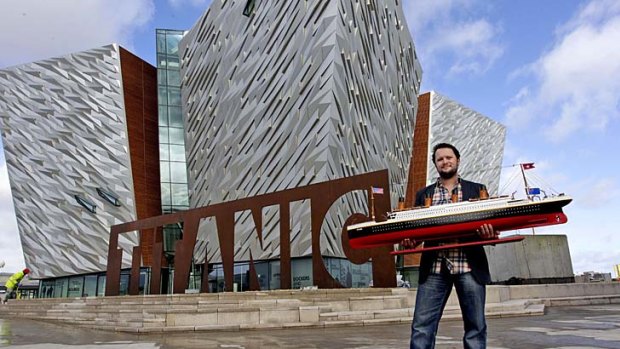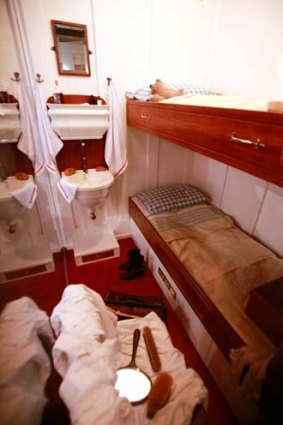By Esther Addley and Henry McDonald

Justin Lowry with his model outside Belfast's Titanic attraction.Credit: AP
ONE hundred years ago this week, the largest moving man-made object on Earth eased into Belfast Lough and set off for New York City. For three years, Belfast had watched the RSS Titanic's enormous hull come together, rivet by rivet, in the Harland and Wolff dockyards, and the launch was a big day for the city: thousands of ticket-holding spectators were joined by a clutch of dignitaries and more than 100 journalists to wave it farewell.
Thirteen days later, the Titanic lay at the bottom of the Atlantic, and 1517 people were dead. "It was such a shock for people [in Belfast]," says Susie Millar, whose great-grandfather was on board, and drowned. "They felt that their pride had been dented. They felt perhaps they were being punished for having that pride in the first place."
For two generations, she says, the city felt "a sense of shame and of embarrassment, and instead of dealing with it, in true Northern Ireland style we swept it under the carpet".
If Belfast was once ashamed of its connection with the Titanic, it is fair to say it has got over it. This week will see the launch of the Titanic Belfast festival, "a fusion of international-scale events" to mark the centenary of what was once merely a terrible tragedy, but has become a source of pride to the city - and potentially a lucrative cash cow.
At least seven plays related to the sinking are being staged in the city, alongside Titanic: The Musical at the city's Grand Opera House. Two choral works have been commissioned, and a memorial garden will be unveiled.
The slipways from which the ship was launched will host an interactive light show and an MTV pop concert, and serve as the start of a new stage of the Circuit of Ireland motor rally.

A third-class cabin.Credit: AFP
Locals can host on-board Titanic-themed hen nights on Belfast Lough, take tours on Titanic-liveried buses or even tuck into the Titanic-themed chips - "All aboard: only 60p".
Biggest and showiest of all, this week will also see the opening of Titanic Belfast, an enormous £100 million ($A150 million) visitor attraction built on the slipway itself, which its cheerleaders hope will do for the city what the Guggenheim did for Bilbao - and filmmaker James Cameron did for the marketability of what was once seen principally as a terrible tragedy.
It's not hard to see where the money has been spent. Using original photographs and video, computer animation, 3D imagery, re-created cabins and a ride in suspended carts, Titanic Belfast's nine galleries tell the story of the ship's construction in what was then the busiest shipyard in the world, its fitout, launch, and its catastrophic end.
The building in which it was housed is no less arresting: a sparkling behemoth that consciously evokes the White Star Line logo, the ship itself and, perhaps oddly, the iceberg that proved its comeuppance. "I'm looking forward to hearing the nicknames Belfast gives it," says its lead architect, Angus Waddington.
The building towers above the now ramshackle Edwardian drawing offices in which the Titanic and its sister ships were designed, but ambitions for Titanic Belfast are even higher. It's flattering, says Mr Waddington, if people compare the building with the Guggenheim: "I think people want to mention that simply because it was such a catalyst for Bilbao and it was seen as a turning point in its reinvention, a shipbuilding, industrial city getting a new lease of life."
Tim Husbands, Titanic Belfast's chief executive, is equally bullish, describing the attraction as "a product that could transform the face of tourism in Northern Ireland".
The centre's estimates predict a £24 million boost to the local economy this year. Others, however, are more sceptical. The Northern Ireland Audit Office has expressed concerns the attraction could struggle to attract the 290,000 visitors it needs each year just to break even. "If predicted visitor numbers do not materialise," it found, "the long-term future of the building would be doubtful."
In the narrow, redbrick terrace streets of Protestant east Belfast, from which many shipyard workers - 15,000 of them in 1912 - were drawn, the shiny new building just down the road in what is now termed Belfast's "Titanic Quarter" is seen as an almost distant curiosity.
John Keenan has a few commemorative teapots in the window of his "Union Jack Shop", but "we've always done that. I'm selling a few more than usual, but there's not that much money about."
Despite living in the shadow of Harland and Wolff's famous yellow cranes - "you can't open your eyes in the morning but you see the cranes" - he says local people have been "badly left behind" by the Titanic commemorations. "Obviously in this part of Belfast, if you go back into your family history there's someone who worked in the shipyards back then. But all the pensioners who live on this road, they are not going to trek over to see a Titanic museum. The tourist buses go about here, they slow down at the murals, click click click click click, but they don't stop."
For Susie Millar, however, who will spend the centenary on board a ship at the North Atlantic wreck site, the renewed global interest in the Titanic, and in Belfast's part in it, is to be welcomed. "We have a great story to tell here in Belfast," she says.
GUARDIAN
Sign up for the Traveller Deals newsletter
Get exclusive travel deals delivered straight to your inbox. Sign up now.